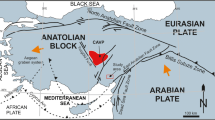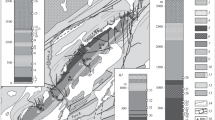Abstract
Voluminous sheets of rhyolitic ignimbrites were crupted during Miocene time in a region of Central America that is underlain by a thick sequence of middle Paleozoic and older metamorphic and plutonic rocks. Strontium isotopic ratios of fifteen ignimbrites range from 0.7035 to as high as 0.7175. These values are markedly higher than those measured for cale-alkaline lavas of the same province, but overlap the range found in basement rocks that may have served as source rocks for anateetic magmas. This relationship is in contrast to that found in the western United States where siliceous ignimbrites are not significantly richer in radiogenic strontium than are the basalt erupted through the same basement series.
Several possible models for the origin of the large volumes of siliceous magma are examined in terms of major-element and isotopic relations, experimental studies of phase relations, and the thermal requirements of melting or assimilating basement rocks. A mathematical model for the effects of assimilation in open and closed systems permits a comparison of predicted chemical and isotopic compositions with those observed and places limits on the plausibility of various schemes of contamination with or without concurrent crystal fractionation. None of the models is without its flaws.
Recent suggestions that large volumes of siliceous magma may be derived from the mantle or lower crust explain certain aspects of the Central American ignimbrites very well if one postulates that the high strontium ratios resulted from contamination of the magma with radiogenic strontium released by the break-down of mieas in basement rocks through which the magmas rose. Such a model fails to explain the apparent restriction of large rhyolitic ignimbrite cruptions to areas underlain by thick continental crust.
Similar content being viewed by others
References
Al-Rawi, Y. andCarmichael, I. S. E., 1967,A note on the natural fusion of granite. Amer. Mineral., v. 52, p. 1806–1814.
Battey, M. H., 1966,The «two-magma theory» and the origin of ignimbrites. Bull. Volc., v. 29, p. 407–424.
Damon, P. E. andAssociates, 1967,Correlation and Chronology of Ore Deposits and Volcanic Rocks. Ann. Prog. Rept. No. COD-689-76, U.S. Atomic Energy Comm., Contract AT (11-1).
Dengo, G., 1962,Tectonic-igneous sequence in Costa Rica. Petrologic Studies, Geol. Soc, America, p. 133–161.
----, andBohenberger, O., 1968,Structural development of northern Central America. InTectonic Relations of the Western Caribbean and Northern Central America, Amer. Assoc. Pet. Geol., Mem. 11, p. 203–220.
Faurf, G., andHurley, P. M., 1963,The isotopic composition of strontium in oceanic and continental basalts: applications to the origin of igneous rocks. Journ. Petrology. v. 4, p. 31–50.
——, andFairbairn, W. H., 1963,An estimate of the isotopic composition of strontium in rocks of the Precambrian Shield of North America. Journ. Geophys. Res., v. 68, p. 2323–2330.
Gomblrg, D. N., Banks, P. O., andMcBirney, A. R., 1968,Guatemala: Preliminary Zircon Ages from Central Cordillera. Science, v. 162, p. 121–122.
Gast, P., Tilton, G. R., andHedge, C., 1964,Isotopic composition of lead and strontion from Ascnesion and Gough Islands. Science. v. 195, p. 1181–1185.
Hedge, C. E., 1966,Variations in radiogenic strontium found in volcanic rocks. J. Geophys. Res., v. 71, p. 6119–6127.
Lipman, P. W., 1966,Water pressures during differentiation and crystallization of some ash-flow magmas from southern Nevada. Amer. Jour. Sci., v. 264, p. 810–826.
Lundgren, L. W., 1966,Muscovite reactions and partial melting in southeastern Counecticut. Jour. Petrology, v. 7, p. 421–453.
McBirney, A. R., 1963,Geology of a part of the Central Guatemadan Cordillera. Univ. Calif. Publ. Geol. Sci., v. 38, p. 177–242.
——, 1969,Compositional variations in Cenozoic cale-alkaline suites of Central America. Internat. Upper Mantle Proj. Sci. Rpt. 16, p. 185–189.
----, andBass, M. N., 1968,Basement rock relations of Northern Central America. InTectonic Relations of the Western Caribbean and Northern Central America. Amer. Assoc. Pet. Geol., Mem. 11, p. 269–280.
——, andWeill, D. L., 1966,Rhyolite magmas of Central America. Bull. Volc., v. 29, p. 435–448.
——, andWilliams, H., 1965,Volcanic History of Nicaragua, Univ. Calit. Publ. Geol. Sci., v. 55, p. 1–65.
Moorbath, S., andBell, J. D., 1965,Strontium Isotope Abundance Studies and Rubidium-Strontium. Age Determinations on Tertiary Igneous Rocks from the Isle of Skye. Northwest Scotland. Jour. Petrology, v. 6, p. 37–66.
Peterman, Z. E., Hedge, C. E., Coteman, R. G., andSnavely, P. D., Jr., 1967,87 Sr/86 Sr Ratios in Some Eugeosyuclinal Sedimentary Rocks and Their Bearing on the Origin of Granitic Magma in Orogenic Belts. Earth Plan. Sci. Letters, v. 2, p. 433–439.
Noble, D. D., andHedge, C. E., 1969,Sr 87/Sr 86 Variations within Individual Ash-flow Sheets. U.S.G.S. Prof. Paper 650-C, p. C133–C139.
Pushkar, P., 1968,Strontium Isotope Ratios in Volcanic Rocks of Three Island Arc Areas. Jour. Geophys. Res., v. 73, p. 2701–2714.
——, 1966,The isotopic composition of strontium in volcanic rocks from island arcs. Ph.D. dissertation, Univ. Calif., San Diego.
Segnit, R. E., andKennedy, G. C., 1961,Reactions and Melting Relations in the System Muscovite-Quartz at High Pressures. Amer. Jour. Sci., v. 259, p. 280–287.
Taylor, H. P., Jr., 1968,The Oxygen Isotope Geochemistry of Igneous Rocks. Contr. Mineral. Petrol., v. 19, p. 1–71.
Williams, H., 1952a, Volcanic History of the Meseta Central Occidental, Costa Rica. Univ. Calif. Publ. Geol. Sci., v. 29, p. 145–180.
——, 1952b, The great eruption of Coseguina, Nicaragua in 1835 with notes on the Nicaraguan volcanic chain. Univ. Calif. Publ. Geol. Sci., v. 29, p. 21–46.
——, 1960,Volcanic history of the Guatemalan Highlands. Univ. Calif. Publ. Geol. Sci., v. 38, p. 1–86.
——, andDengo, G., 1964,Geologic reconnaissance of southeastern Guatemala. Univ. Calif. Publ. Geol. Sci., v. 50, p. 1–57.
——, andMcBirney, A. R., 1969,Volcanic history of Honduras. Univ. Calif. Publ. Geol. Sci., v. 85, p. 1–101.
——, andMeyer-Abich, H., 1955,Volcanism in the southern part of El Salvador. Univ. Calif. Publ. Geol. Sci., v. 32, p. 1–64.
Yoder, H. S., 1969,Calc-alkaline andesites: experimental data bearing on the origin of their assumed characteristics. Internat. Upper Mantle Proj. Sci. Rpt. 16, p. 77–89.
Author information
Authors and Affiliations
Additional information
Program in Geochronology Contribution 144. Geochronology Laboratory, University of Arizona, Tucson.
Rights and permissions
About this article
Cite this article
Pushkar, P., McBirney, A.R. & Kudo, A.M. The isotopic composition of strontium in Central American ignimbrites. Bull Volcanol 35, 265–294 (1971). https://doi.org/10.1007/BF02596955
Received:
Published:
Issue Date:
DOI: https://doi.org/10.1007/BF02596955




